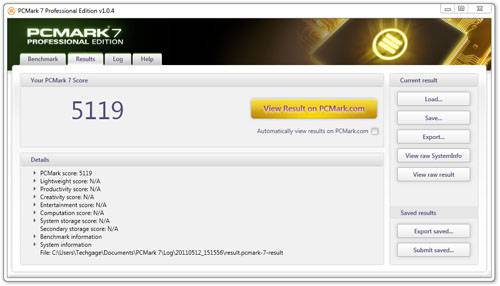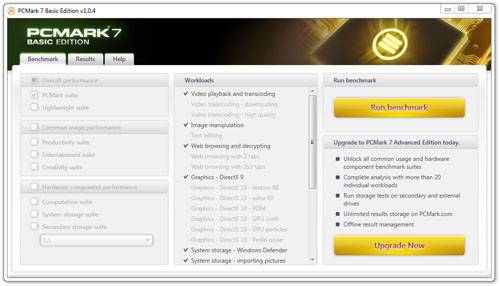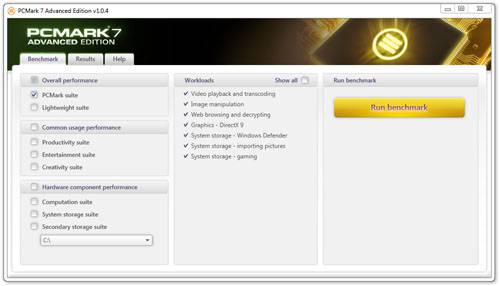- Qualcomm Launches Snapdragon 4 Gen 2 Mobile Platform
- AMD Launches Ryzen PRO 7000 Series Mobile & Desktop Platform
- Intel Launches Sleek Single-Slot Arc Pro A60 Workstation Graphics Card
- NVIDIA Announces Latest Ada Lovelace Additions: GeForce RTX 4060 Ti & RTX 4060
- Maxon Redshift With AMD Radeon GPU Rendering Support Now Available
A Quick Look at Futuremark’s PCMark 7
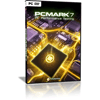
Futuremark has launched the latest version of its popular PC benchmarking tool, PCMark, and as its “7” name suggests, it’s designed exclusively for use with Windows 7. A couple of notable changes were made to both the test organization of the program, and also its pricing schemes. Join us as we take a quick look to see what’s been added or refined.
Contest Alert! We’re giving away FIVE copies of PCMark 7 “Advanced”. Details on entering can be found in our forums.
It’s been quite a while since we last saw a PCMark release, and in fact, there have been not one, but two 3DMark versions to hit the scene since that time. While we half-expected to see a new PCMark version not long after the Windows 7 launch, it’s clear that Futuremark didn’t want to rush something out the door too quickly – at least, not before a proper 3DMark follow-up that introduced the DirectX 11 capabilities Vantage lacked.
With PCMark 7, Futuremark performed a bit of an overhaul on the application in order to deliver the most relevant tests possible. Rather than keep test names that are rather ambiguous such as “Memories” and “TV and Movies”, PCMark 7 simplifies things by creating five main test suites that are for the most part, unrelated to each other. These include “Entertainment”, “Creativity”, “Productivity”, “Computation” and “Storage”. Of course, there’s also the overarching “PCMark” test which uses parts of the five aforementioned tests. A “Lightweight” test has also been introduced for testing with netbooks and other entry-level computers.
As the title of this article suggests, this isn’t a review of PCMark 7, but rather a quick look to see what’s brought to the table, and also to discuss how it will be used in our own content. With PCMark Vantage, we used its tests for our CPU, motherboard and storage-related content. With 7, we don’t see that changing, and we’ll be upgrading all of our suites as soon as we can – barring any unforeseen occurrence.
For the first time in PCMark history, 7 is not designed to run on multiple OSes. Rather, it’s exclusive to Windows 7, as you might imagine by its name. I am not sure of the full reason for this, but it could be that Vista just wasn’t that reliable to benchmark under (something I do tend to agree with). While this limitation might bother some, it can be assumed that most people who take benchmarking seriously will be using the most up-to-date version of Windows.
Also for the first time ever, in either PCMark or 3DMark history, the “Advanced” edition of the program will retail for $39.95 – double the cost of the same edition for Vantage. Again, this is a change I’m not too aware of the reasoning behind, but as the Advanced edition is meant to be used by those who aren’t just looking for a simple score, it can be considered appropriate.
Thanks in part to the higher price of Advanced, Futuremark made sure that its Basic edition wasn’t too limiting. Unlike Vantage, which capped out at a single run unless a $6.95 fee was paid, PCMark 7 allows an unlimited number of runs of the standard suite. The limitation of being able to store just one online result stands.
Here’s a total break-down of the limitations, or lack of, for each edition:
|
Features
|
Basic
|
Advanced
|
Professional
|
|
PCMark Test
|
Yes
|
Yes
|
Yes
|
|
Lightweight Test
|
No
|
No
|
Yes
|
|
Entertainment Test
|
No
|
No
|
Yes
|
|
Creativity Test
|
No
|
No
|
Yes
|
|
Productivity Test
|
No
|
No
|
Yes
|
|
Computation Test
|
No
|
No
|
Yes
|
|
Storage Test
|
No
|
No
|
Yes
|
|
Unlimited runs?
|
Yes
|
Yes
|
Yes
|
|
Offline results?
|
No
|
Yes
|
Yes
|
|
Command-line?
|
No
|
No
|
Yes
|
|
Personal account?
|
Yes
|
Yes
|
Yes
|
|
Browse & Search results?
|
Yes
|
Yes
|
Yes
|
|
Unlimited results storage?
|
No
|
Yes
|
Yes
|
|
Advert-free?
|
No
|
Yes
|
Yes
|
|
Priority support?
|
No
|
No
|
Yes
|
|
Commercial use?
|
No
|
No
|
Yes
|
|
Price
|
$0
|
$29.95
|
$995.00
|
Here is what each version looks like:
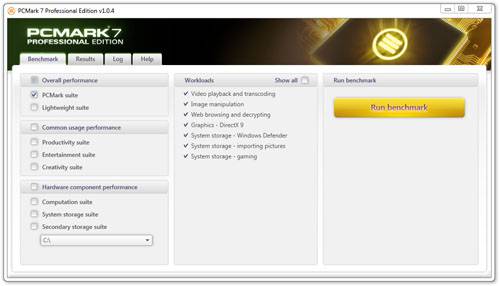
PCMark 7 – Professional Edition
You’ll notice that the Professional and Advanced editions look nearly identical, and that’s to be expected. Professional has just a couple of minor features added to the other tabs meant almost exclusively for corporations or those who need things like custom test options and command-line automation.
Across the 7 separate tests that PCMark 7 includes, there are 25 individual workloads spread across them all. Futuremark breaks these tests as follows:
- The PCMark test measures overall system performance and returns an official PCMark score.
- The Lightweight test measures the capabilities of entry level systems unable to run the full PCMark test.
- The Entertainment test measures system performance in entertainment, media and gaming scenarios.
- The Creativity test measures performance in typical creativity scenarios involving images and video.
- The Productivity test measures system performance scenarios using the Internet and office applications.
- The Computation test contains workloads that isolate the computation performance of the system.
- The Storage test contains workloads that isolate the performance of the PC’s storage system.
The “PCMark” test is the one that Futuremark considers to be the standard, and will likely be the one most people will use for comparison’s sake. It focuses a fair bit on storage tests, highlighting the importance of equipping your PC with an SSD for the ultimate performance. Storage tests include Windows Defender, photo importing and gaming. In addition to these storage tests, the PCMark suite also tests out video playback performance, graphics (including DX9), image manipulation, Web browsing and decrypting.
The “Lightweight” test scales things down, and rather than include gaming and Windows Defender in the storage tests, it replaces those with “Starting applications” and “Adding music” – typical workloads that entry-level PCs will deal with. Also, text editing and Web browsing with only three tabs is also taken into consideration.
When we use PCMark 7 for the sake of our CPU or motherboard reviews, we’ll run the whole kit and kaboodle, with the exception of the “Lightweight” test since it’s mostly redundant. For our storage reviews, we’ll focus exclusively on the Storage test, which tackles Windows Defender, importing photos, video editing, Windows Media Center, adding music, starting applications and also gaming.
Up to this point, we haven’t run too many iterations of PCMark 7, but so far I’m liking what I’m seeing. The entire suite takes less time to run overall when compared to PCMark Vantage, and the results after a run are clear and concise (I was glad to not see a repeat of 3DMark 11 when it first launched).
For more thorough information on Futuremark’s latest application, check out the official site, and for those who want to dive in a bit deeper, you can download the reviewer’s guide from us here (1MB, right-click, save as).
Discuss this article in our forums!
Have a comment you wish to make on this article? Recommendations? Criticism? Feel free to head over to our related thread and put your words to our virtual paper! There is no requirement to register in order to respond to these threads, but it sure doesn’t hurt!
Support our efforts! With ad revenue at an all-time low for written websites, we're relying more than ever on reader support to help us continue putting so much effort into this type of content. You can support us by becoming a Patron, or by using our Amazon shopping affiliate links listed through our articles. Thanks for your support!




